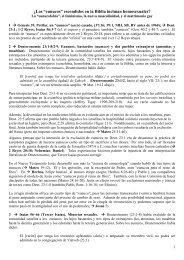Deuteronomy: - Fundación Otras Ovejas de Argentina
Deuteronomy: - Fundación Otras Ovejas de Argentina
Deuteronomy: - Fundación Otras Ovejas de Argentina
Create successful ePaper yourself
Turn your PDF publications into a flip-book with our unique Google optimized e-Paper software.
Num 15:37-41 (See The Jewish Study Bible 2004:315, Num 15:37-41 note):<br />
37 ―Yahweh said to Moses 38 ‗Speak to the Israelites and say to them: ‗Throughout the generations to come you are<br />
to make tassels on the corners of your [linen] garments, with a blue [woolen] cord on each tassel. 39 You will<br />
have these tassels to look at and so you will remember all the commands of Yahweh, that you may obey them<br />
and not prostitute yourselves by going after the lusts of your own hearts and eyes. 40 Then you will remember<br />
to obey all my commands and will be consecrated to your God. 41 I am Yahweh your God, who brought you<br />
out of Egypt to be your God. I am Yahweh your God.‘‖ � cf the priestly linen garments with tassels<br />
containing wool thread (Ex 28:4-6, 39:27-29).<br />
Ex 28:5 ―They [the artisans]…shall receive the gold, the blue, purple, and crimson yarns [wool] and the fine linen‖ (to make<br />
the priestly vestments; JSB 2004:172, note Ex 28:5; similarly, obeyed in Ex 39:27-29).<br />
Yet the woman with hemorrhage was healed by touching the wool tassels on the fringe (kraspedon) of Jesus‘ linen garment<br />
(Mat 9:20 // Lk 8:44; cf. Mk 5:25-34), which contained two types of thread (linen and wool), <strong>de</strong>spite the prohibitions in Lev<br />
19:19c and Deut 22:11 (Danker BDAG 2000:564; NJB Mat 23:5 note on tassel). Elsewhere multitu<strong>de</strong>s were healed by<br />
touching the woolen tassels of Jesus‘ linen garment (Mk 6:56; Mat 14:36; cf. Paul as healer in Acts 19:11). ―Jewish men<br />
(and possibly women) wore fringes to remind them of the commandments (Num 15:38; Deut 22:12)‖ (Jewish Annotated NT<br />
note, 2011:18-19). JSB 254<br />
This woman represents a sexual minority, (Amy-Jill Levine, Women in Scripture 20001:443) whom Jesus dignifies by calling<br />
her ―daughter‖ (of Abraham?) and to whom he gives priority over the literal daughter of the synagogue lea<strong>de</strong>r Jairus. She<br />
had been economically in<strong>de</strong>pen<strong>de</strong>nt (as divorced-prostitute and/or, widow), having spent all of her‖money on physicians but<br />
only grew worse (Mc 5:26; omitted by Dr. Luke). Prostitutes (Mat 21:31-32; 9:9-13; 1:1-17) were known for superstitions<br />
and wearing tassels of two types of cloth, wool from animals and linen from plants (R. Nelson, <strong>Deuteronomy</strong>, 2002:269).<br />
The woman‘s blood flow ma<strong>de</strong> her ritually unclean for twelve years (Lev 15:19-27; Ezk 36:17) but Jesus‘ positive outflowing<br />
healing power prevented his being ma<strong>de</strong> unclean by her touch (Mk 7:19; Rom 14:14, 20; see ―uncleanness‖ in Rom 1:24).<br />
Moreover, the woman is healed by touching Jesus‘ tassels, ma<strong>de</strong> of linen and wool, which represented an infraction of the<br />
prohibition in Leviticus 19:19 and Deut 22:11 (see the prohibitions of male-male anal sex in Lev 18:22; 20:13). Jesus‘ tassels,<br />
ma<strong>de</strong> of linen and wool (contrary to Lev. 19:19 and Deut 22:11), characterized him as a typical Jewish male but Jewish high<br />
priests were comman<strong>de</strong>d to wear tassels in the shape of pomegranates, alternating with bells on the hem of their linen<br />
garments, which distinguished them from laity (Ex 28:4-6; 39:27-29; cf. ―Hear we not thy gol<strong>de</strong>n bells?‖ in F. R. Havergal‘s<br />
hymn ―Thou art Coming).<br />
29

















